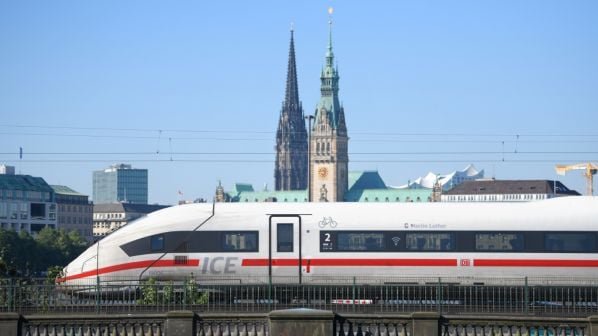Photo credit: DB AG/Oliver Lang
The four German mobile operators, railway company Deutsche Bahn (DB) and the government have signed an agreement to significantly improve 5G service on the Hamburg-Berlin main line. Under the agreement, trains could be manufactured with different types of glass windows that would allow signals to penetrate a car without having to be transmitted through an antenna on top of the car.
As part of a planned track upgrade between August 2025 and April 2026, the partners say they want to create an ‘Innovation Route for Mobile Network Expansion’ by erecting dedicated telephone masts to provide improved communications and signaling to trains and drivers using the mobile network. technology known as Future Rail Mobile Communication System (FRMCS). The operators will also look at the extent to which they can use that infrastructure to improve the 5G customer experience in the wagons, with a Gbps target for on-board throughput.
A statement said: “Given the technical and economic challenges in providing services to rail passengers, this can only succeed through a joint effort from all parties involved. The partners have agreed on the ambitious goal of a joint gigabit provision on trains in the Memorandum of Understanding, which will be signed today [Monday 21 October].”
The 278 kilometer rail link between Hamburg and Berlin is one of the busiest routes in Germany, with up to 230 trains and around 30,000 passengers per day. During the upcoming renovation of the route, DB will consolidate work on tracks, switches and overhead lines, creating overtaking opportunities, modernizing several stations and updating signaling and safety technology. DB will also use the planned multi-month line closure to build the infrastructure for the future Mobile Rail Communications System (FRMCS), which will replace the current railway radio GSM-R across Europe by 2035.
The masts and communications cabinets, power and fiber optic connectivity built for FRMCS delivery will also be made available by DB to mobile companies for testing and passenger line coverage.
Part of the mobile tests examines how the signal from the track masts in the carriages can be sent to customers. The companies will look at developing windows that allow mobile signals to penetrate better. Currently, the external metal coating – designed to protect cars from sunlight – hinders signal propagation. DB said windows that allow mobile signals to better penetrate the car interior will gradually replace existing repeaters that receive signals via antennas on the cars and transmit them to the interior.
The mobile network companies – 1&1, DT, Telefonica O2 and Vodafon – want to jointly develop an architecture that works both technically and commercially. They and the Federal Ministry of Digital and Transport have set the goal of providing gigabit coverage to passengers on the future route and ensuring integration with the FRMCS.
FRMCS is a standards-based approach deployed in Europe to replace GSM-R, the existing technology that provides dedicated rail coverage. The first version of the FRMCS technical specifications for interoperability, produced by the European Union Agency for Railways (ERA), was published in 2023, and a second version is expected in 2027. Deployment of experimental lines is expected to begin in 2025. operator SNCF said the migration phase in France to FRMCS will take place between 2028 and 2035, with gradual commercial operation from 2032. The schedule is demanding, as all facilities will have to be fully operational by 2035 to tackle the aging of GSM networks. R, for which some manufacturers no longer guarantee maintenance from 2030.
An SNCF blog post states that SNCF Réseau carries out research and development projects in collaboration with manufacturers (Siemens, Alstom, Kontron, Thalès, Nokia, etc.) and other European infrastructure managers (Austria’s OEBB, Switzerland’s SBB, Germany’s DB Infrago , the Spanish ADIF and the Dutch Prorail). These projects include:
- 5G-RACOM (5G for resilient and green rail communications): a French-German project studying solutions for FRMCS. It aims, among other things, to study, develop and test radio technologies that can support both 2G and 5G systems during the migration phase, and is supported by the French government through the France 2030 investment plan.
- R2 DATO : a program that focuses on train automation, with increasing emphasis on FRMCS.
- MORAN 2 🙁 MO gal Radio for RA always Networking in Europe ) also known as “Destination 2”. This program, which is currently under construction, can validate product development standards. It will last three years, between 2024 and 2027.





